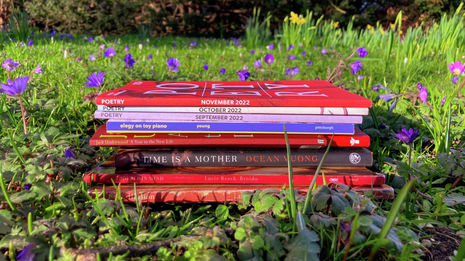Poems to step from winter into spring
Deputy Arts Editor Leo Kang shares some of his favourite poems to read while the seasons turn and crocuses bloom

The cold still stubbornly hangs on while crocuses bud in college gardens – in other words, March is here. I’ve put together a platter of poems – four winter, four spring – to offer a taste of snowy nostalgia but also of longer days and greener trees. I hope you enjoy them as much as I do!
“Rune Poems from Bergen, Norway, 13th and 14th Century” – Unknown, translated by Eirill Falck
As Falck explains, in 1955, there was a fire in the harbour district of Bergen, Norway. In the wreckage, hundreds of runic inscriptions were uncovered. The find revealed that runes were not only used for formal occasions but for casual, often erotic, notes – essentially, 800-year-old dms. In these three notes, the poet calls out for his forbidden love, his “wisewoman”, amid bitterly cold ranges of snow-capped mountains.
Riding home on winter solstice, Frost stopped and "bawled like a baby"
“Stopping by Woods on a Snowy Evening” – Robert Frost
This is one of the best loved poems of the 20th century – Frost himself called it his "best bid for remembrance". The story goes that, riding home on winter solstice, Frost stopped and “bawled like a baby”, knowing he hadn’t sold enough at the market to give his family a good Christmas. Another story goes that he went out at sunrise after a long night and wrote this poem in “just a few minutes without strain”. In any case, “Stopping by Woods on a Snowy Evening” is made more beautiful by mysteries, from its “lovely, dark” woods to its famously hypnotic final lines.
“Between Autumn Equinox and Winter Solstice, Today” – Emily Jungmin Yoon
With spring equinox only a few weeks away, it’s nice to look back on what made winter wintery – for me, it was huddling in my room with a steaming mug of tea. Yoon’s poem takes the bare, cold bones of that moment and, with “heat” and “lightning”, transforms them into something luminous.
Rhyme and rhythm burst like flowers and fill his lines with life
“Chrysalis” – Arthur Sze
Sze is a poet of shifting surfaces, of breaking waves and whales’ backs, of the tiny noises of passing people and the hugeness of planets in the sky. In “Chrysalis”, he moves through all that and more in breathtaking, hypersensitive detail. It's the perfect poem for tuning yourself to the turning seasons, and it makes my skull tingle every time I read it.
“Spring” – Gerard Manley Hopkins
Ah, Gerard – a favourite of Englings everywhere. In the rather stuffy Victorian era, Hopkins was revolutionary for his use of sprung rhythm, where the spondee (DUM-DUM) replaces the iamb (dee-DUM) as the dominant measure. This forceful, fervent style can be seen here in his sonnet on spring, where rhyme and rhythm (“weeds, in wheels, shoot long and lovely and lovely and lush”) burst like flowers and fill his lines with life.
“Spring” – Edna St. Vincent Millay
Like Robert Frost, Millay was a great melder of modernist and traditional poetry. “Spring” was her first poem in free verse, and it captures sensory pleasures in plain language: “The spikes of the crocus. / The smell of the earth is good.” At the same time, Millay introduces modernist doom and gloom. She muses on "maggots" and "brains of men" and her opening line (“To what purpose, April, do you return again?”) parallels T. S. Eliot’s “The Waste Land” (“April is the cruellest month”). If you fancy a sharply cynical take on spring, one that undercuts new life with old death, then this is your poem.
“Vita Nova” – Louise Glück
In 2020, Glück was awarded the Nobel Prize in Literature for the “austere beauty” of her poems that “makes individual existence universal”. “Vita Nova” is a perfect example of this – a memory of a spring day where every detail, from the “little cakes” to the “laughter for no reason”, seems translucent and touchable.
“Spring Reign” – Dean Young
“There are no ordinary feelings,” Dean Young once wrote, “Just as there are no ordinary spring days or kicked over cans of paint.” This is a good summary of Young's approach to poetry – taking ordinary, everyday feelings and refracting them till they turn rainbow-coloured. This poem is a surrealist “Thank you” to spring, featuring a “tetrahedron”, “philosophy ants”, the “River Styx” and, of course, “rain”. Amid all the strangeness, though, Young is saying something genuine – that we have no idea what the world is doing, but we can be thankful for it anyway.
 News / Cambridge postgrad re-elected as City councillor4 May 2024
News / Cambridge postgrad re-elected as City councillor4 May 2024 News / Gender attainment gap to be excluded from Cambridge access report3 May 2024
News / Gender attainment gap to be excluded from Cambridge access report3 May 2024 News / Some supervisors’ effective pay rate £3 below living wage, new report finds5 May 2024
News / Some supervisors’ effective pay rate £3 below living wage, new report finds5 May 2024 Comment / Accepting black people into Cambridge is not an act of discrimination3 May 2024
Comment / Accepting black people into Cambridge is not an act of discrimination3 May 2024 News / Academics call for Cambridge to drop investigation into ‘race realist’ fellow2 May 2024
News / Academics call for Cambridge to drop investigation into ‘race realist’ fellow2 May 2024




